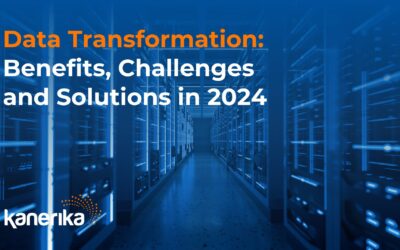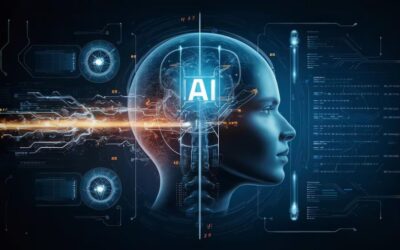MLOps, or Machine Learning operations, is a crucial aspect of any organization’s growth strategy, given the ever-increasing volumes of data that businesses must grapple with. MLOps helps optimize the machine learning model development cycle, streamlining the processes involved and providing a competitive advantage.
The concept behind MLOps combines machine learning, a discipline in which computers learn and improve their knowledge based on available data, with operations, which is the area responsible for deploying machine learning models in a development environment. MLOps bridges the gap between the development and deployment teams within an organization.
What is MLOps?
MLOps combines the power of Machine Learning with the efficiency of operations to optimize organizational processes, resulting in a competitive edge. As the confluence of Machine Learning and operations, MLOps bridges the gap between developing and deploying models, melding the strengths of both the development and operations teams.
In a typical Machine Learning project, you would start with defining objectives and goals, followed by the ongoing process of gathering and cleaning data. Clean, high-quality data is essential for the performance of your Machine Learning model, as it directly impacts the project’s objectives. After you develop and train the model with the available data, it is deployed in a live environment. If the model fails to achieve its objectives, the cycle repeats. It’s important to note that monitoring the model is an ongoing task.
Challenges Faced by Operations Teams in ML Projects
In ML projects, your operations team deals with various obstacles beyond those faced during traditional software development. Here, we discuss some key challenges impacting the process:
- Data Quality: ML projects largely depend on the quality and quantity of available data. As data grows and changes over time, you have to retrain your ML models. Following a traditional process is not only time-consuming but also expensive
- Diverse Tools and Languages: Data engineers often use a wide range of tools and languages to develop ML models. This variety adds complexity to the deployment process
- Continuous Monitoring: Unlike standard software, deploying an ML model is not the final step. It requires continuous monitoring to ensure optimal performance
- Collaboration: Effective communication between the development and operations teams is essential for smooth ML workflows. However, collaboration can be challenging due to differences in their skills and areas of expertise
Implementing MLOps principles and best practices can help address these challenges and streamline your ML projects. By adopting a more agile approach, automating key processes, and encouraging cross-team collaboration, you can optimize your ML model development cycle, ultimately resulting in improved efficiency and better business outcomes.
Key Benefits of MLOps
You may encounter various challenges while implementing Machine Learning operations (MLOps) in your organization. To address these hurdles, consider adopting the following strategies and best practices:
1. Automate the pipeline
Streamline the Machine Learning lifecycle by automating essential tasks such as data preparation, model training, and deployment. Integration of continuous integration and continuous delivery (CI/CD) principles can speed up the process while ensuring the agile delivery of quality models.
2. Standardize your tools, environments, and workflows
By standardizing the technologies and frameworks used, you can minimize the complexity of integrating diverse tools and languages during the deployment stage. Collaboration among data scientists, engineers, and developers becomes more transparent and efficient with a shared platform and codebase.
3. Opt for best practices and design architectures
Implement best practices and architectural patterns to streamline the Machine Learning process. These practices include data validation, feature engineering, and exploratory data analysis, ensuring your models are built on high-quality and relevant data.
4. Monitor model metrics and performance
Actively monitor the performance and accuracy of your deployed models. Continuous monitoring allows you to detect any data drift or model drift that may affect your outcomes. Regularly update the datasets and retrain models to maintain optimal performance.
5. Version control and reproducibility
Implement version control systems and code repositories, such as GitHub or Azure DevOps, to streamline the management of your Machine Learning components. Having a versioning system in place enables better collaboration and ensures reproducibility of workflows.
6. Secure and govern your environment:
To safeguard critical assets and comply with regulations, prioritize security and governance measures in the Machine Learning process. Implement robust data lineage, access controls, and documentation practices to protect sensitive information and maintain compliance.
7. Leverage existing resources and technologies:
Use scalable technologies, platforms, and resources, such as Azure Machine Learning, to optimize the performance and management of your ML workflows. These platforms will enable efficient scaling, resource utilization, and delivery of your models in real-time.
DevOps vs MLOps
1. Purpose and Focus
- DevOps:
- Purpose: Enhance software development and delivery processes
- Focus: Integration of development (Dev) and operations (Ops) teams to improve collaboration and productivity
- Key Areas: Continuous Integration (CI), Continuous Deployment (CD), infrastructure as code, monitoring, and logging
- MLOps:
- Purpose: Streamline the deployment and management of machine learning models
- Focus: Integrate data scientists, machine learning engineers, and operations teams to manage the lifecycle of machine learning models
- Key Areas: Model training, validation, deployment, monitoring, and retraining
2. Workflow
- DevOps:
- Development: Continuous development and integration of software code
- Testing: Automated testing to ensure code quality
- Deployment: Automated deployment pipelines to deliver software updates quickly
- Monitoring: Continuous monitoring and feedback loops for application performance and reliability
- MLOps:
- Data Preparation: Ingestion, cleaning, and preprocessing of data
- Model Training: Continuous training and validation of machine learning models
- Model Deployment: Automating the deployment of models to production environments
- Model Monitoring: Tracking model performance, detecting drift, and triggering retraining processes
3. Tools and Technologies
- DevOps:
- CI/CD Tools: Jenkins, GitLab CI, CircleCI
- Configuration Management: Ansible, Puppet, Chef
- Containerization: Docker, Kubernetes
- Monitoring: Prometheus, Grafana, ELK Stack
- MLOps:
- Data Management: Apache Kafka, Apache Airflow
- Model Training: TensorFlow, PyTorch, Scikit-learn
- CI/CD for ML: Kubeflow, MLflow, TFX
- Monitoring: Prometheus, Grafana, custom ML monitoring tools
4. Challenges
- DevOps:
- Cultural Shift: Fostering collaboration between development and operations teams
- Automation: Building and maintaining automated pipelines
- Scalability: Ensuring infrastructure can scale with application demands
- MLOps:
- Data Quality: Ensuring high-quality data for model training
- Model Drift: Monitoring and maintaining model performance over time
- Integration: Seamlessly integrating machine learning models into existing systems
5. Lifespan and Maintenance
- DevOps:
- Software Lifecycle: Focus on continuous integration and delivery of software applications
- Maintenance: Regular updates, patches, and feature enhancements
- MLOps:
- Model Lifecycle: Emphasis on the continuous training, deployment, and monitoring of models
- Maintenance: Ongoing model evaluation, retraining, and updating based on new data and performance metrics
Implementing MLOps in Your Organization: Best Practices
1. Automate Model Deployment
- Consistency: Ensure models are deployed uniformly to reduce errors
- Faster Time-to-Market: Speed up the transition from development to production
- Seamless Updates: Regularly update models without disrupting the system
2. Start with a Simple Model and Build the Right Infrastructure
- Faster Iteration: Quickly identify and fix issues
- Easier Debugging: Simplify troubleshooting with straightforward models
- Scalability: Develop an infrastructure that can handle growth
- Integration: Facilitate collaboration between data scientists and engineers
3. Enable Shadow Deployment
- Validation: Test new models in a production-like environment
- Risk Mitigation: Identify and resolve issues without affecting live systems
- Performance Comparison: Compare new models with current production models
4. Ensure Strict Data Labeling Controls
- Clear Guidelines: Establish comprehensive labeling instructions
- Annotator Training: Train and assess annotators regularly
- Multiple Annotators: Use consensus techniques to improve data quality
- Monitoring and Audits: Regularly review the labeling process for quality
5. Use Sanity Checks for External Data Sources
- Data Validation: Ensure data meets predefined standards
- Detect Anomalies: Identify and handle missing values and outliers
- Monitor Data Drift: Regularly check for changes in data distribution
6. Write Reusable Scripts for Data Cleaning and Merging
- Modularize Code: Create reusable, independent functions
- Standardize Operations: Develop libraries for common data tasks
- Automate Processes: Minimize manual intervention in data preparation
- Version Control: Track changes in data scripts to prevent errors
7. Enable Parallel Training Experiments
- Accelerate Development: Test different configurations simultaneously
- Efficient Resource Utilization: Distribute workloads across available resources
- Improved Performance: Increase the chances of finding the best model
- Experiment Management: Track and analyze results effectively
8. Evaluate Training Using Simple, Understandable Metrics
- Business Alignment: Choose metrics that reflect project goals
- Interpretability: Ensure metrics are easy to understand for all stakeholders
- Consider Trade-offs: Balance multiple metrics for a comprehensive evaluation
9. Automate Hyper-Parameter Optimization
- Improved Performance: Enhance model accuracy with optimal hyperparameters
- Efficiency: Reduce manual tuning efforts
- Consistency: Ensure reproducible results through automation
- Continuous Improvement: Integrate HPO into CI/CD pipelines
10. Continuously Monitor Deployed Models
- Detect Model Drift: Identify performance degradation early
- Issue Identification: Quickly address anomalies and errors
- Maintain Trust: Ensure reliable model performance for stakeholders
- Compliance: Keep records for regulatory and auditing purposes
11. Enforce Fairness and Privacy
- Fairness Assessment: Evaluate and mitigate model biases
- Privacy-Preserving Techniques: Implement differential privacy and federated learning
- Policy Reviews: Stay updated on regulations and guidelines
12. Improve Communication and Alignment Between Teams
- Clear Objectives: Define and communicate project goals
- Documentation: Maintain detailed records for knowledge sharing
- Regular Meetings: Encourage open discussions and feedback
- Version Control: Use systems like Git for managing code and data
Conclusion
MLOps has emerged as a strategic component for successfully implementing Machine Learning projects in organizations of all sizes. By bridging the gap between development and deployment, MLOps fosters greater collaboration and streamlines workflows, ultimately delivering immense value to your business.
Successfully leveraging MLOps (Machine Learning Operations) principles and practices paves the way for efficient, scalable, and secure Machine Learning operations. Stay up-to-date with the latest technologies, best practices, and trends in MLOps to ensure that your organization remains competitive and reaps the full benefits of Machine Learning.
Choose your AI/ML Implementation Partner
Kanerika has long acknowledged the transformative power of AI/ML, committing significant resources to assemble a seasoned team of AI/ML specialists. Our team, composed of dedicated experts, possesses extensive knowledge in crafting and implementing AI/ML solutions for diverse industries. Leveraging cutting-edge tools and technologies, we specialize in developing custom ML models that enable intelligent decision-making. With these models, our clients can adeptly navigate disruptions and adapt to the new normal, bolstered by resilience and advanced insights.
FAQs
What are the main elements of an MLOps architecture?
- Data: Collection, storage, and preprocessing of data used for training and evaluation.
- Model: Creation, training, and evaluation of Machine Learning models.
- Deployment: Integration of models into production systems, including server and edge deployments.
- Monitoring: Tracking model performance, data drift, and overall system health.
- Pipeline Management: Ensuring end-to-end workflows are reproducible, scalable, and efficient.
- Collaboration: Tools and practices for facilitating teamwork between ML engineers, data scientists, and other stakeholders.
How is MLOps different from Classic DevOps?
- MLOps focuses specifically on Machine Learning workflows, whereas DevOps is for general software development.
- MLOps manages both data pipelines and model lifecycle, while DevOps typically handles code deployment and infrastructure management.
- MLOps requires specialized skills in Machine Learning , data engineering, and analytics, whereas DevOps focuses on software engineering.
Which tools are commonly used in MLOps?
- Data Management: Apache Kafka, Hadoop, Spark, and TensorFlow Data Validation
- Version Control: Git, DVC, and MLflow
- CI/CD: Kubernetes, Jenkins, Azure Pipelines, and CircleCI
- Model Management: Tensorflow Extended, MLflow, and Seldon
- Model Monitoring: Prometheus, Grafana, and TensorBoard
What are the main duties of an MLOps Engineer?
- Designing and implementing robust MLOps pipelines
- Ensuring data privacy, compliance, and security
- Optimizing infrastructure, resource utilization, and costs
- Collaborating with data scientists, ML engineers, and other stakeholders
- Monitoring and maintaining model performance and system health
Are there any suggested MLOps frameworks?
- TensorFlow Extended (TFX)
- MLflow
- Kubeflow
- Metaflow
- Seldon




















